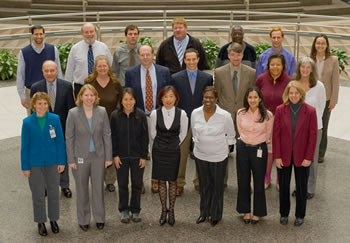About OSA

The OSA Staff
The EPA Science Advisor position was established by the former Administrator Christie Whitman in her May 24, 2002, memorandum on "Strengthening Science at the Environmental Protection Agency (PDF)" (2 pp, 417K).
The Science Advisor works across the Agency to ensure that the highest quality science is better integrated into the Agency's policies and decisions. In this capacity, the Science Advisor leads the Office of the Science Advisor (OSA) and chairs the Agency's Science Policy Council which reviews selected science issues that have implications across program and regional offices. The mission of the OSA is to provide leadership and serve as an honest broker for cross-Agency science, science policy, and technology issues.
The Science Advisor is responsible for:
- Ensuring availability and use of the “best science” at the Agency
- Advising the EPA Administrator on science and technology issues and their relationship to Agency policies, procedures, decisions
- Chairing the EPA Science Policy Council
- Oversight of the Program in Human Research Ethics
- Oversight of the Risk Assessment Forum
- Leadership in leveraging Earth observations and modeling for Agency missions
The Office of the Science Advisor was established by former Acting Administrator Linda Fisher in her July 11, 2003, memorandum (PDF) (1 page, 16K) to provide leadership in establishing specific mechanisms for ensuring that sound science plays a prominent role in all regulatory decisions. These efforts help ensure regulations are interpreted and enforced in a manner consistent with the science supporting them and will strengthen EPA's overall scientific performance.
Dr. Pai-Yei Whung, EPA’s Chief Scientist, oversees the Office of the Science Advisor. As the Chief Scientist, Dr. Whung shares fully with the EPA Science Advisor in planning, policy development and implementation, oversight, and direction of all cross-Agency scientific efforts.
The Office of the Science Advisor has responsibility in several principle areas:
Science Policy Council - The Science Policy Council (SPC) is chaired by the Science Advisor. The SPC is an important cross-Agency group of senior managers that focuses on major science policy issues and approves positions for the Agency.
The Science Policy Council (SPC) serves as a mechanism for addressing EPA's many significant science policy issues that go beyond regional and program boundaries. With a goal of integrating policies that guide Agency decision-makers in their use of scientific and technical information, the SPC works to implement and ensure the success of selected initiatives recommended by external advisory bodies such as the National Research Council and the Science Advisory Board, as well as others such as the Congress, industry and environmental groups, and Agency staff. In this way, the SPC contributes guidance for selected EPA regulatory and enforcement policies and decisions.
Examples of SPC activities include:
- Nanotechnology,
- Peer Review,
- Risk Characterization,
- Genomics, and
- Regulatory Environmental Modeling.
Environmental Technology Initiative- The Environmental Technology Initiative seeks to catalyze the development, verification, and deployment of sustainable technologies that help solve environmental problems.
Risk Assessment Forum - The Risk Assessment Forum is a standing committee of senior EPA scientists established to promote Agency-wide consensus on difficult and controversial risk assessment issues and to ensure that this consensus is incorporated into appropriate Agency risk assessment guidance.
Examples of RAF activities include:
- Guidelines for Carcinogen Risk Assessment
- Guidelines for Ecological Risk Assessment
- Guidelines for Exposure Assessment
Observation and Modeling Activities - The observation and modeling-related programs are comprised of the Global Earth Observation System of Systems (GEOSS), Council for Regulatory Environmental Modeling (CREM), and Forum on Environmental Measurements (FEM) programs. Collectively these programs seek to strengthen and better integrate observational and modeling techniques and activities into Agency processes.
Program in Human Research Ethics - The Human Studies Review Board was chartered on February 21, 2006 to provide advice, information and recommendation on issues related to the scientific and ethical aspects of human subjects research, to the EPA Administrator, through EPA's Science Advisor. The HSRB is a Federal advisory committee operating in accordance with the Federal Advisory Committee Act. ![]()
Contact Information
Learn more about
Role and Use of Science at EPA
Post-Doctoral Research Program
Other Links of Interest where you can learn about other EPA organizations, our partners in science, biography of the Science Advisor, databases and documents.
You will need Adobe Reader to view some of the files on this page. See EPA's PDF page to learn more.
![[logo] US EPA](https://webarchive.library.unt.edu/eot2008/20090508010334im_/http://www.epa.gov/epafiles/images/logo_epaseal.gif)